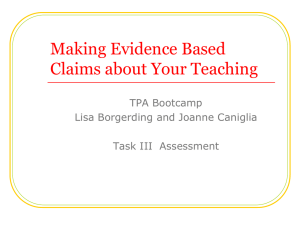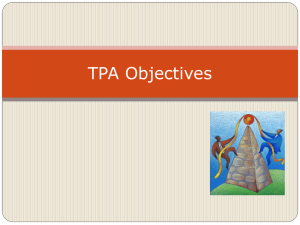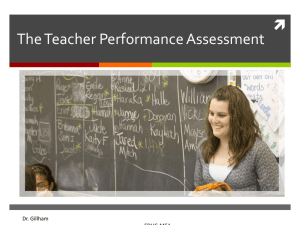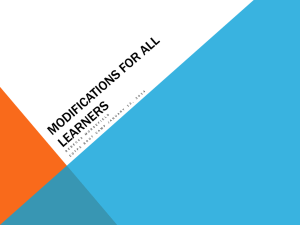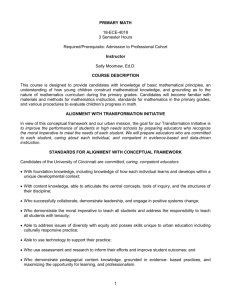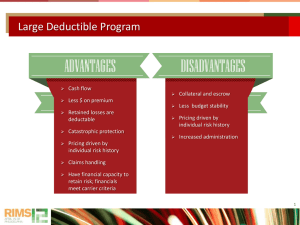What is the Teacher Performance Assessment (TPA)? The Teacher
advertisement
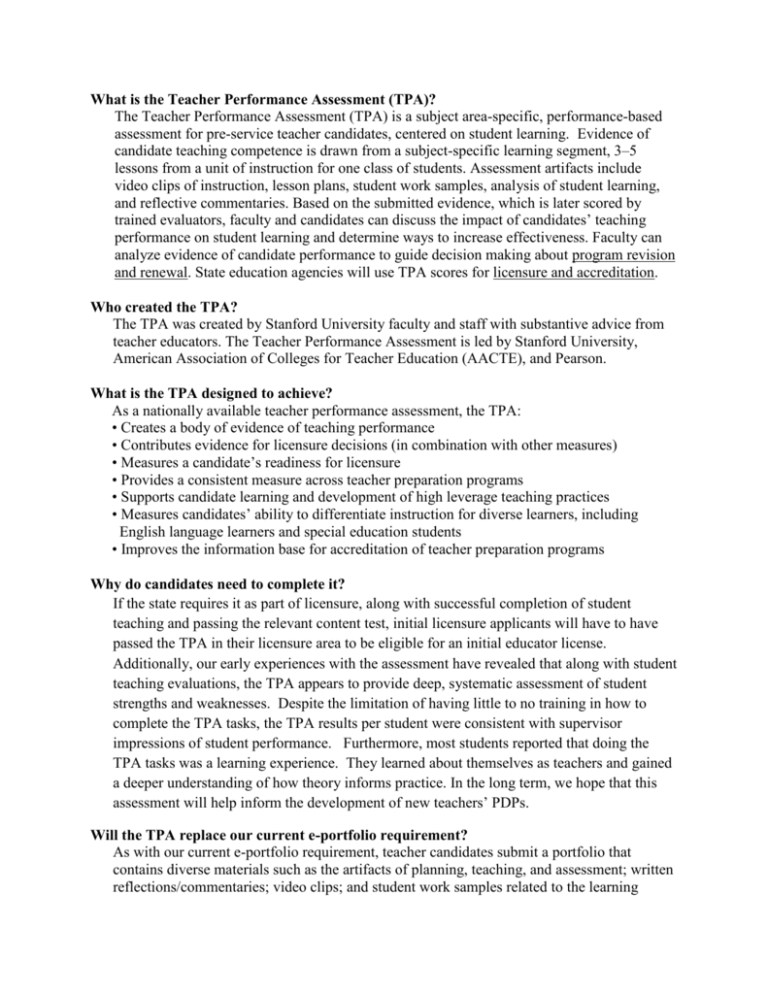
What is the Teacher Performance Assessment (TPA)? The Teacher Performance Assessment (TPA) is a subject area-specific, performance-based assessment for pre-service teacher candidates, centered on student learning. Evidence of candidate teaching competence is drawn from a subject-specific learning segment, 3–5 lessons from a unit of instruction for one class of students. Assessment artifacts include video clips of instruction, lesson plans, student work samples, analysis of student learning, and reflective commentaries. Based on the submitted evidence, which is later scored by trained evaluators, faculty and candidates can discuss the impact of candidates’ teaching performance on student learning and determine ways to increase effectiveness. Faculty can analyze evidence of candidate performance to guide decision making about program revision and renewal. State education agencies will use TPA scores for licensure and accreditation. Who created the TPA? The TPA was created by Stanford University faculty and staff with substantive advice from teacher educators. The Teacher Performance Assessment is led by Stanford University, American Association of Colleges for Teacher Education (AACTE), and Pearson. What is the TPA designed to achieve? As a nationally available teacher performance assessment, the TPA: • Creates a body of evidence of teaching performance • Contributes evidence for licensure decisions (in combination with other measures) • Measures a candidate’s readiness for licensure • Provides a consistent measure across teacher preparation programs • Supports candidate learning and development of high leverage teaching practices • Measures candidates’ ability to differentiate instruction for diverse learners, including English language learners and special education students • Improves the information base for accreditation of teacher preparation programs Why do candidates need to complete it? If the state requires it as part of licensure, along with successful completion of student teaching and passing the relevant content test, initial licensure applicants will have to have passed the TPA in their licensure area to be eligible for an initial educator license. Additionally, our early experiences with the assessment have revealed that along with student teaching evaluations, the TPA appears to provide deep, systematic assessment of student strengths and weaknesses. Despite the limitation of having little to no training in how to complete the TPA tasks, the TPA results per student were consistent with supervisor impressions of student performance. Furthermore, most students reported that doing the TPA tasks was a learning experience. They learned about themselves as teachers and gained a deeper understanding of how theory informs practice. In the long term, we hope that this assessment will help inform the development of new teachers’ PDPs. Will the TPA replace our current e-portfolio requirement? As with our current e-portfolio requirement, teacher candidates submit a portfolio that contains diverse materials such as the artifacts of planning, teaching, and assessment; written reflections/commentaries; video clips; and student work samples related to the learning segment. However, the TPA has many aspects that are unlike our e-portfolio requirements and processes that are directed at establishing the reliability and validity of the assessment, including uniform task requirements, and trained scorers using research based rubrics. Because the TPA is more focused than our standards, we anticipate the TPA will be folded into or aligned with our standards and become part or nearly all of a student’s e-portfolio. Isn’t this too much to ask student teachers to accomplish? We acknowledge that the TPA tasks require more work in documentation, especially as it relates to the written commentary, and attention to detail on the part of the student teacher. Unfortunately, the level of documentation required is necessary to ensure that the evaluation of the student teacher’s portfolio is accurate and that feedback can be detailed enough to inform the future learning and practice of the teacher candidate. In addition to the greater amount of work, the task formats and the overall process are new to all associated with our teacher education programs. However, in future years, the task formats and processes will be embedded into the programs so that students and cooperating teachers will have experience with the TPA requirements prior to the summative evaluation. If our experience with the TPA parallels our experience with the beginning of our e-portfolio system and UW-Madison Teacher Education standards, and/or California’s experiences with this type of evaluation, it will take a few years for us to adjust to the new system. After that, what now appears to be onerous or extreme will become a natural part of our teacher education programs. Despite the growing pains, we believe that the value of the TPA outweighs the difficulties that will be associated with the initial years. The TPA tasks focus on the core of all teachers’ instructional practices: (a) planning based on knowledge of the students as well as the content, (b) teaching and engaging all students by attending to the needs of individual students as well as the larger group, (c) using assessment to guide instruction and inform student learning, and (d) improving student learning as well as teacher growth through teachers’ analyses of their own teaching performance. These practices are assessed as part of all field experiences; as such, they are not unique to this assessment. However, we currently do not have a way to systematically document and readily communicate about our students’ skills and knowledge to our multiple audiences, our programs and our students themselves. The TPA provides us with a way to clearly document the thinking and skills of teacher candidates in the critical areas. Most important, the TPA provides us with a research-based tool to help us ensure that only those teacher candidates who have met the standards associated with effective entry level teachers will be recommended for licensing. How will it impact your district/school/classroom? It is important to emphasize that the TPA is an assessment, not something separate and special. It should be integrated into what the teacher candidate normally does. It should not interrupt what is being done in the classroom. However, it may offer benefits to the teacher candidate-cooperating teacher relationship and the relationship between the teacher education programs and the schools. Cooperating teachers and teacher candidates may find that work around the tasks provides a context for better coordinated support and offers opportunities for targeted conversations around the expectations for a newly licensed teacher (the rubrics) and the thinking of the teacher candidate around the core practices (the commentary prompts). Additionally, the TPA tasks offer more data for coaching conversations with teacher candidates’ supervisors and the cooperating teachers. As a result, the TPA will add to the definition of to the cooperating teacher’s role in coaching the teacher candidates. Furthermore, it will help to facilitate communication because it provides a common language for supervisors and/or teacher candidates. California’s work using this type of performance evaluation reveals that the evaluation process strengthens and enhances partnerships between teacher education programs and the PK-12 schools. The benefits include More informed communication with cooperating teacher Program data to help guide support of the cooperating teachers, as well as informing change in teacher education programs by providing real-time information about their program’s efficacy in the assessed areas Opportunity to provide professional development that can enhance the quality of supervision and mentoring, in general. Being trained to score portfolios has ended up being excellent professional development for supervisors, cooperating teachers, and principals. Partnerships that assist in new teacher support program

